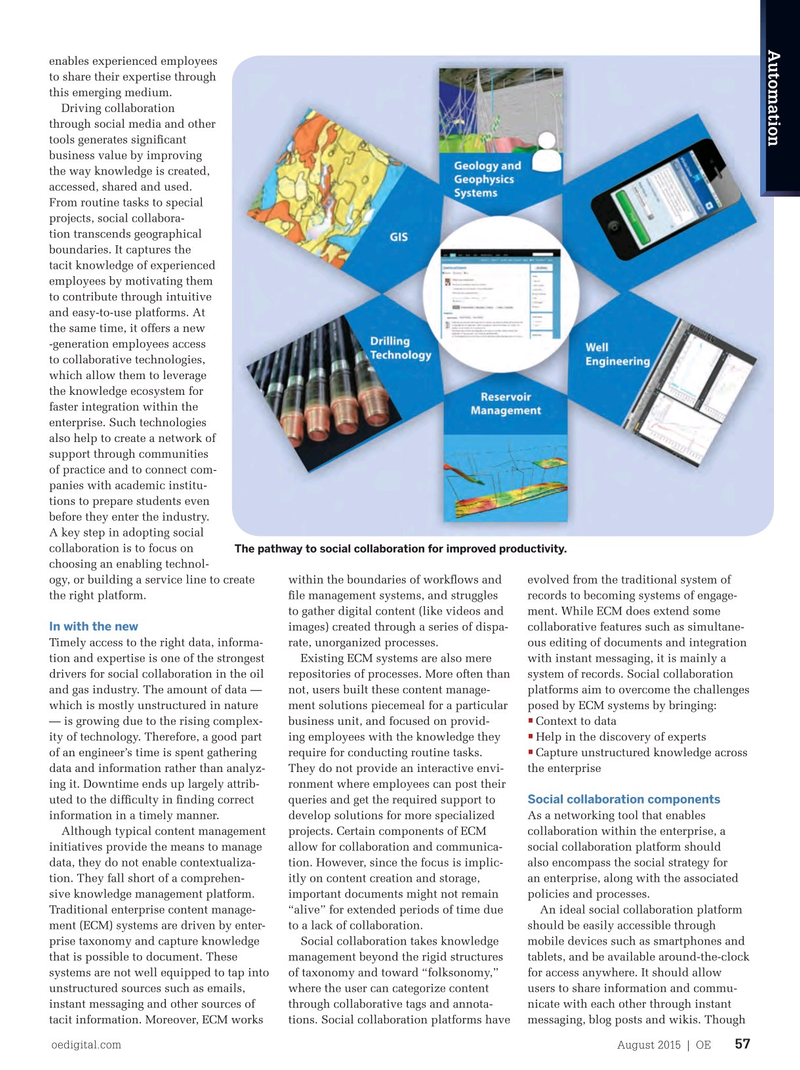
Page 55: of Offshore Engineer Magazine (Aug/Sep 2015)
Read this page in Pdf, Flash or Html5 edition of Aug/Sep 2015 Offshore Engineer Magazine
Automation enables experienced employees to share their expertise through this emerging medium.
Driving collaboration through social media and other tools generates signifcant business value by improving the way knowledge is created, accessed, shared and used.
From routine tasks to special projects, social collabora- hostile locations. This shifts the focus tion transcends geographical to unconventional exploration tech- boundaries. It captures the niques that require the support of digital tacit knowledge of experienced technologies and extensive technical employees by motivating them expertise. However, fnding the talent to contribute through intuitive with experience in new technologies and and easy-to-use platforms. At unconventional production techniques is the same time, it offers a new not a simple task. -generation employees access
Taking a quick look, it is easy to see to collaborative technologies, the current education system does not which allow them to leverage support the growing need for skilled the knowledge ecosystem for resources. People graduating as geologists faster integration within the every year, from universities across the enterprise. Such technologies globe, form only a miniscule percentage also help to create a network of of graduates compared to other disci- support through communities plines like law, medicine and engineer- of practice and to connect com- ing. Therefore, oil and gas companies panies with academic institu- should either train new hires or recruit tions to prepare students even personnel from other countries to bridge before they enter the industry. this gap. Industry players remain chal- A key step in adopting social lenged to train these employees quickly collaboration is to focus on
The pathway to social collaboration for improved productivity.
to maintain productivity. Effective choosing an enabling technol- knowledge management and collabora- ogy, or building a service line to create within the boundaries of workfows and evolved from the traditional system of tion is not only critical to bridge these the right platform. fle management systems, and struggles records to becoming systems of engage- to gather digital content (like videos and ment. While ECM does extend some
In with the new images) created through a series of dispa- collaborative features such as simultane-
Timely access to the right data, informa- rate, unorganized processes. ous editing of documents and integration tion and expertise is one of the strongest Existing ECM systems are also mere with instant messaging, it is mainly a drivers for social collaboration in the oil repositories of processes. More often than system of records. Social collaboration and gas industry. The amount of data — not, users built these content manage- platforms aim to overcome the challenges which is mostly unstructured in nature ment solutions piecemeal for a particular posed by ECM systems by bringing: • — is growing due to the rising complex- business unit, and focused on provid- Context to data • ity of technology. Therefore, a good part ing employees with the knowledge they Help in the discovery of experts
Images from Tata Consultancy Services.
The key capabilities of an ideal social collaboration platform. • of an engineer’s time is spent gathering require for conducting routine tasks. Capture unstructured knowledge across data and information rather than analyz- They do not provide an interactive envi- the enterprise gaps and prevent loss of critical exper- ing it. Downtime ends up largely attrib- ronment where employees can post their
Social collaboration components tise, but it is also necessary to build new uted to the diffculty in fnding correct queries and get the required support to competencies. information in a timely manner. develop solutions for more specialized As a networking tool that enables
A more connected workplace that Although typical content management projects. Certain components of ECM collaboration within the enterprise, a enables an easy exchange of information initiatives provide the means to manage allow for collaboration and communica- social collaboration platform should is a business imperative. data, they do not enable contextualiza- tion. However, since the focus is implic- also encompass the social strategy for tion. They fall short of a comprehen- itly on content creation and storage, an enterprise, along with the associated
Social collaboration sive knowledge management platform. important documents might not remain policies and processes.
While, it would be easy to say this is just Traditional enterprise content manage- “alive” for extended periods of time due An ideal social collaboration platform a human resources issue, it is important ment (ECM) systems are driven by enter- to a lack of collaboration. should be easily accessible through to address the issue from a business prise taxonomy and capture knowledge Social collaboration takes knowledge mobile devices such as smartphones and perspective. The solution starts with that is possible to document. These management beyond the rigid structures tablets, and be available around-the-clock understanding the needs of “digital systems are not well equipped to tap into of taxonomy and toward “folksonomy,” for access anywhere. It should allow natives” entering the organization who unstructured sources such as emails, where the user can categorize content users to share information and commu- are comfortable with social networking instant messaging and other sources of through collaborative tags and annota- nicate with each other through instant tools, and providing an environment that tacit information. Moreover, ECM works tions. Social collaboration platforms have messaging, blog posts and wikis. Though oedigital.com August 2015 | OE 57 056_OE0815_Automation.indd 57 7/21/15 9:52 PM

 54
54

 56
56